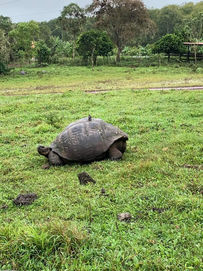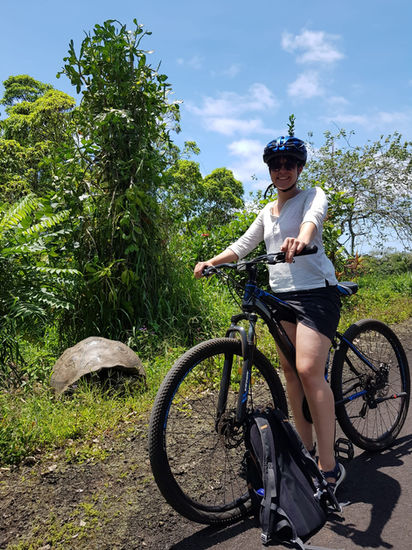
observe the
giant Tortoise
Follow in the footsteps of giant tortoises, an emblematic species, and admire the transition zone forest in all its splendor. The giants roam free in and around the Galapagos Frontier reserve.
The Galapagos giant tortoise is the largest tortoise species on Earth. It can reach 300 kg (660 lbs) in the wild.
It has a spectacular longevity, one of the longest in the entire animal world, living up to more than 170 years. In the Galápagos Islands, giant tortoises are the ecological equivalent of elephants. Even their old scientific name (Geochelone elephantopus) evoked similarities.
Galapagos tortoises lead an uncomplicated life, grazing grass, leaves and cacti, sunbathing and resting for almost 16 hours a day. A slow metabolism and the ability to store large amounts of water allow it to survive up to a year without eating or drinking. Galapagos tortoises play a key role in shaping their ecosystem by dispersing plant seeds in their dung where they can store more than 50 species of seeds. Turtles are ecosystem engineers, that is, organisms that can greatly influence the areas in which they inhabit. When they are in pools they move nutrients from terrestrial to aquatic areas, leaving a free fertilizer.
Turtles are slow-moving reptiles with an average long-distance walking speed of 0.3 km/h. However, although feeding giant tortoises move slowly, cruising with no apparent direction, if they have a purpose, such as moving towards water or nesting areas, they can move with surprising speed and determination given their size. Tagged individuals have been reported to have traveled 8 miles in 2 to 3 days.
Reproduction and Life Cycle
Giant tortoises reach maturity at around 20-25 years of age. They usually breed during the hot season, which occurs from January to May. Mating can last several hours, after which the female migrates to an area with dry, sandy soil. There, she digs a hole in which she lays from two to 16 eggs. The eggs hatch after about 130 days, after which the young turtles must work their way to the surface.
The turtles leave the highlands and migrate to the lowlands to feed on the lush vegetation. When the rains stop, the lower areas dry out, but the higher parts are wet throughout the year and the vegetation continues to grow. Many, but not all, adult tortoises return to these areas where they have a secure food source.
Like other reptiles, Galapagos tortoises are cold-blooded animals. They spend much of the day basking in the sun to warm up. When the sun goes down and the temperature drops, tortoises sleep partially submerged in mud, water, or brush to keep warm. Turtles are extremely peaceful creatures.






























